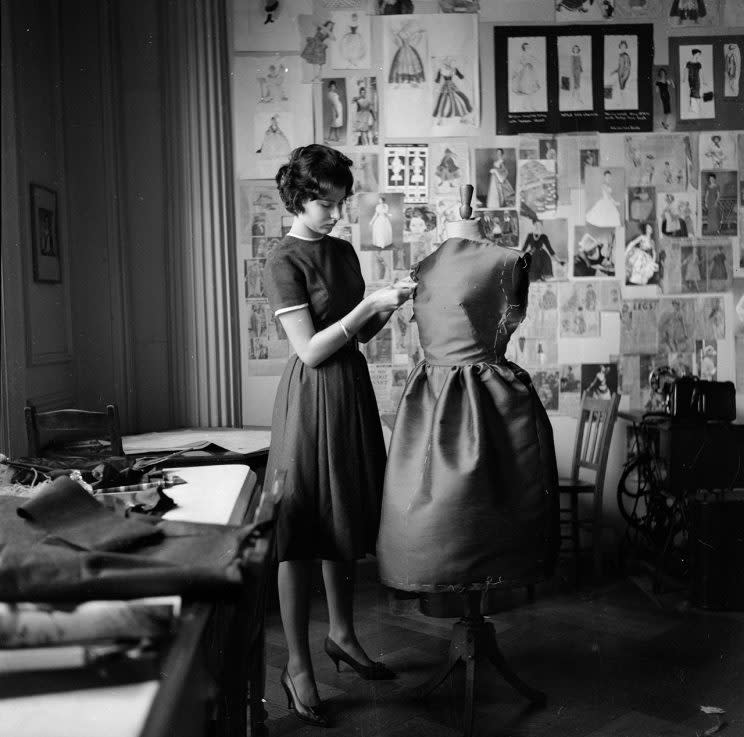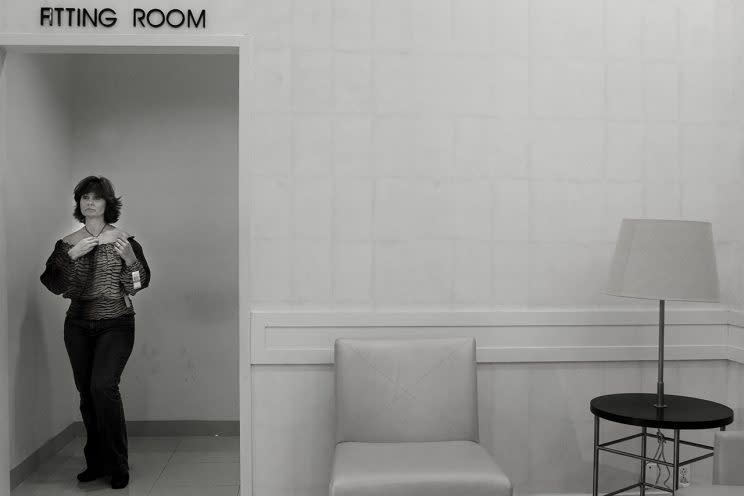The Reason Why Your Clothes Don’t Fit

Do any of us put any stock in clothing sizes? A woman might wear a size 12 in a pair of pants from a store specializing in office separates, a size medium in a dress from that same retailer, a size medium blouse from a mass retailer, a size 10 in a pair of jeans from a sporty-mom’s catalog, and a size 14 in pants from a niche designer.
Sizes are more like guesstimates than prescriptive measurements, leading to a lot of angst and frustration in the changing room and disappointment in front of the mirror at home. The industry believes that about 40 percent of all apparel bought online is returned, according to Newsweek, and about 60 percent of those returns are caused by problems with fit. Buyers and sellers alike are frustrated by our current sizing system, which doesn’t seem to benefit anyone except the U.S. Postal Service and UPS. Crazily enough, our mothers had the same problem — and our grandmothers probably did too.
The situation was simpler in preindustrial America, when many women knew how to sew and well-to-do fashionistas had their clothing made to measure by professional tailors and dressmakers. Sizes were determined by a system of proportionate measurements, says Kathleen Fasanella, a professional patternmaker and consultant who runs a small garment factory in Albuquerque, N.M. Patternmakers had a tool called an L square, with a chart on the back that showed the pattern parts and their relation to each other. Sizing represented scale to the people making the clothes, says Fasanella, but when factories took over, that meaning was lost.

That happened in the 20th century when the growing middle class started to favor ready-to-wear clothing made possible by new technology and mass production. Americans started to move out of cities, and the catalog industry took off. Manufacturers were basically just winging it, assigning sizes based on nonstandard measurements. Women had increasing options of cute, ready-to-wear styles — but they had to know what size they wore in order to know what size to buy. Sizing-related setbacks were costly for the catalog industry. One estimate from Time magazine pegged industry losses at $10 million a year. In the late 1930s, overwhelmed with returns and unhappy customers, designers and catalog merchandisers implored the government to do something about the sad sizing situation.
The United States Department of Agriculture responded by teaming up with the Works Project Administration to fund a survey. They sent two statisticians, Ruth O’Brien and William Shelton, to collect the measurements of women around the country. This study of nearly 15,000 women took nearly a year and involved nearly 500 relief workers. It was an extremely impressive undertaking, says Lynn M. Boorady, associate professor of fashion and textile technology. Researchers took 59 distinct measurements of a woman’s body, from bust to waist to hip length to arm length, which they planned to analyze for proportional relationships and patterns. This data was ultimately used to produce a system of 27 different sizes — which, unfortunately, is about 20 sizes too many for the average retailer, says Boorady.
More problematic, by far, was the fact that O’Brien and Shelton’s data was skewed. First, it only accounted for white women. On top of that, many of the women who agreed to participate in the study (in which a small stipend was offered to offset the indignity of stripping down to bloomers) were unmarried and economically disadvantaged and therefore undernourished, says Boorady. There also wasn’t a protocol for taking the measurements (say, requiring all participants to stand up straight when researchers were checking their height or lift their arm a certain way during the arm measurements).
Despite these significant issues, the sizing system was out there for all manufacturers, retailers, and designers to use. But shoppers were still ending up with ill-fitting clothing in “their size” and sending it back to retailers. So a decade later, the Mail Order Association of America asked the National Bureau of Standards (now the National Institute of Standards and Technology) to reanalyze O’Brien and Shelton’s data and conduct another study of women’s measurements. Women’s sizes, represented by even numbers from 8 to 38, were derived from bust, waist, and hip size. The results became the basis of the system that we still use today.
The numbers are flexible, though. In 1995, ASTM International, a private global organization that comes up with voluntary product standards, started publishing body measurements for women’s sizing based on a 1958 system. They have a committee that meets twice a year, says Boorady, to tweak the numbers to determine what the sizes mean.
In the meantime, most designers have taken great liberties with the system and now size clothes to fit the types of bodies they want to dress. Companies provide their own measurements for sizes, and stores, for their part, buy in the size ranges that best accommodate their target demographic, says Boorady. (That’s why you see a mind-boggling variety in sizes at your local retailer, as this Racked article shows).

Over time, the average American body has made a noticeable transformation. Data from the Centers for Disease Control and Prevention shows that the average American adult is more than 24 pounds heavier today than in 1960, and obesity rates have more than doubled. Additional sizes were created to fit these larger, curvier shoppers. But here’s where things get interesting: We don’t see an ever-expanding range of sizes, even though we know we need them to accommodate the population’s expansive girth as well the increasing differentiation of women’s body types. (Remember, the original Eves of sizing models were white and waiflike.)
Instead, brands have added negative-numbered sizes at the small end of the range, so that while the 1958 standard listed 8 as its smallest size and the 1995 ASTM standard listed a size 2, we now see 00 and 000 size options at J.Crew. If you happen to purchase the same size now as 20 years ago, you may have noticed that items in your size at mass retailers like Old Navy seem roomier than in the past.
This phenomenon — a growing range of body types, a sizing system that’s only expanding at the small end of the scale — has been referred to as “vanity sizing.” Many people believe that the industry is deliberately putting smaller numbers on larger items of clothing to make customers feel better about themselves — the sartorial equivalent of telling someone they look like they lost weight before asking them for money. And it’s true that you’ll likely find women’s vintage dresses that each seem like a cruel trompe l’oeil: They’re labeled with your size, but you can barely zip them up. Slate reports that a size 14 or 16 today is the rough equivalent of a size 8 in 1958, while a size 2 in the 2011 ASTM standard falls between a 1995 standard size 4 and 6.
Some garment industry insiders like Fasanella claim that vanity has nothing to do with it. “Sizes evolve, just like people do,” she says. “The brands have simply been sizing up along with the general American population.” (Fasanella runs a blog devoted to what she calls “the myth” of vanity sizing.) Those wonky ASTM size metamorphoses from the 1950s, in which an 8 then is a 16 now? They were based on a different sizing system altogether (the L square versus the body measurement survey), so the comparison is meaningless, she says. The changes from the 1960s to the 2000s? Again, those were probably based on a different system: the O’Brien and Shelton data, which everyone agrees was not representative of the average woman then, never mind now. Vintage frocks? Well, it’s a fact that most of us are bigger now. Fasanella says claiming there’s a mass conspiracy against shoppers to trick them into buying more clothes doesn’t hold up: People are more likely to buy clothes that flatter the figure, not the ego.
Nevertheless, some women refuse to buy clothing in a size that surpasses their personal threshold. “I can fit into a size 14 at some stores,” says a 37-year-old fshopper who’d prefer to remain anonymous. “So I won’t even go into those stores. I prefer to shop at places where ‘my size’ is a 10.”
And she knows exactly which places do this. That’s the secret of the sizing madness: It creates strong brand loyalty. “Most retailers and brands are not interested in creating a uniform sizing standard,” says Marshal Cohen, chief industry analyst of the NPD Group, who’s been covering the retail clothing industry for more than 40 years. They like being able to define fit in their terms, according to their demo. “They want to maintain their brand identity.” So if your research (i.e., hours of trying on clothes) has shown you that Ann Taylor’s “Kate” pants in size 8 make your bottom look better than any other pants on sale today, then you’re going to be BFFs with Ann and Kate.

Companies are working hard on improving fit. A 2002-2003 study used body scanners to get a more accurate read on the shape and sizes of about 14,000 women as well as men. Lynn Boorady worked on this study, and she explains that one big takeaway was that the hourglass figure used by most manufacturers was a lousy basis for sizing because most Americans are more rectangular-shaped. That insight led to the creation of designations like “slim fit” and “curvy fit,” which are used to size pants made for a bigger bottom and a smaller waist. The industry is currently trying to take body scanning to the next level, says Boorady. By analyzing body measurements as well as shopping and fit preferences (because body-con isn’t for everyone, nor is baggy), they want to create an algorithm to predict a more satisfactory fit.
Some online retailers are already taking a low-tech approach based on the same idea: They post the height and weight of the model wearing the clothes, show a short video clip of her walking and moving in the garment, and provide suggestions like Amazon.com’s (“If you like the fit of that item, you might like this one…”).
There’s still no good substitute for a fitting session in the privacy of your own home. So while designers and retailers keep trying to nail the fit, we’ll just keep trying on their clothes — and making friends with people who know how to sew.
Find your #PowerLook with Yahoo Style’s complete guide to fashion that makes you feel invincible, and post your #PowerLook to be featured on our feed!

